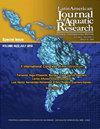Effect of periods of delayed first exogenous feeding in goldfish Carassius auratus (Linnaeus, 1758) larvae
IF 0.8
4区 农林科学
Q3 FISHERIES
Latin American Journal of Aquatic Research
Pub Date : 2023-04-30
DOI:10.3856/vol51-issue2-fulltext-2993
引用次数: 1
Abstract
Four treatments were established to evaluate the effect of delayed first exogenous feeding and subsequent feeding periods on the development of goldfish larvae. The fasting and feeding periods were arranged as follows: T1 (0DFA:30DF), T2 (4DFA:26DF), T3 (8DFA:22DF), and T4 (12DFA:18DF), where DFA are the days of fasting and DF are the days of feeding. The larvae were kept in community tanks for each repetition, with 75 larvae per tank (3.75 larvae L-1). There was no significant difference in total length or final weight between larvae submitted to 0, 4, and 8 days of feed deprivation. However, larvae submitted to 12 DFA had higher values of the same variables than the other treatments. No significant difference in larval survival was observed between T1, T2, and T3, but T4 negatively influenced survival. Under the conditions evaluated, the point of no return was 4 DFA. Dead larvae were partly eaten in the fasting treatments. The delayed first feeding should be avoided in large-scale productions since it significantly reduces survival during cultivation. This article results from research funded by the Pescarte Environmental Education Project (PEA/IBAMA).金鱼鲫鱼(Carassius auratus, Linnaeus, 1758)幼虫延迟首次外源摄食时间的影响
建立了四个处理方法来评估延迟第一次外源喂养和随后的喂养期对金鱼幼虫发育的影响。禁食和喂食时间安排如下:T1(0DFA:30DF)、T2(4DFA:26DF)、T3(8DFA:22DF)和T4(12DFA:18DF),其中DFA为禁食天数,DF为喂食天数。幼虫被保存在群落水槽中,每次重复,每个水槽有75只幼虫(3.75只幼虫L-1)。在0、4和8天的饲料剥夺下,幼虫的总长度或最终重量没有显著差异。然而,与其他处理相比,接受12 DFA处理的幼虫具有更高的相同变量值。在T1、T2和T3之间未观察到幼虫存活率的显著差异,但T4对存活率产生负面影响。在所评估的条件下,不返回点为4 DFA。死幼虫在禁食处理中被部分吃掉。在大规模生产中应避免延迟第一次喂食,因为这会显著降低培养过程中的存活率。本文来自佩斯卡特环境教育项目(PEA/IBAMA)资助的研究。
本文章由计算机程序翻译,如有差异,请以英文原文为准。
求助全文
约1分钟内获得全文
求助全文
来源期刊

Latin American Journal of Aquatic Research
FISHERIES-MARINE & FRESHWATER BIOLOGY
CiteScore
1.70
自引率
10.00%
发文量
44
审稿时长
4-8 weeks
期刊介绍:
Latin American Journal of Aquatic Research- LAJAR is the continuation of the journal Investigaciones Marinas (1970-2007) and is published since 2008 by the Escuela de Ciencias del Mar, Facultad de Ciencias del Mar y Geografía of the Pontificia Universidad Católica de Valparaíso. LAJAR is an “Open Access” journal that publishes in English language, original research articles, reviews and short communications on aquatic science, which contain the results of research conducted in aquaculture or in oceanic and coastal marine waters of Latin America.
The following topics are considered: Physical Oceanography, Chemical Oceanography, Marine Biogeochemistry, Marine Pollution and Toxicology, Marine Geology and Geophysics, Biological Oceanography, Fisheries and Aquaculture.
 求助内容:
求助内容: 应助结果提醒方式:
应助结果提醒方式:


